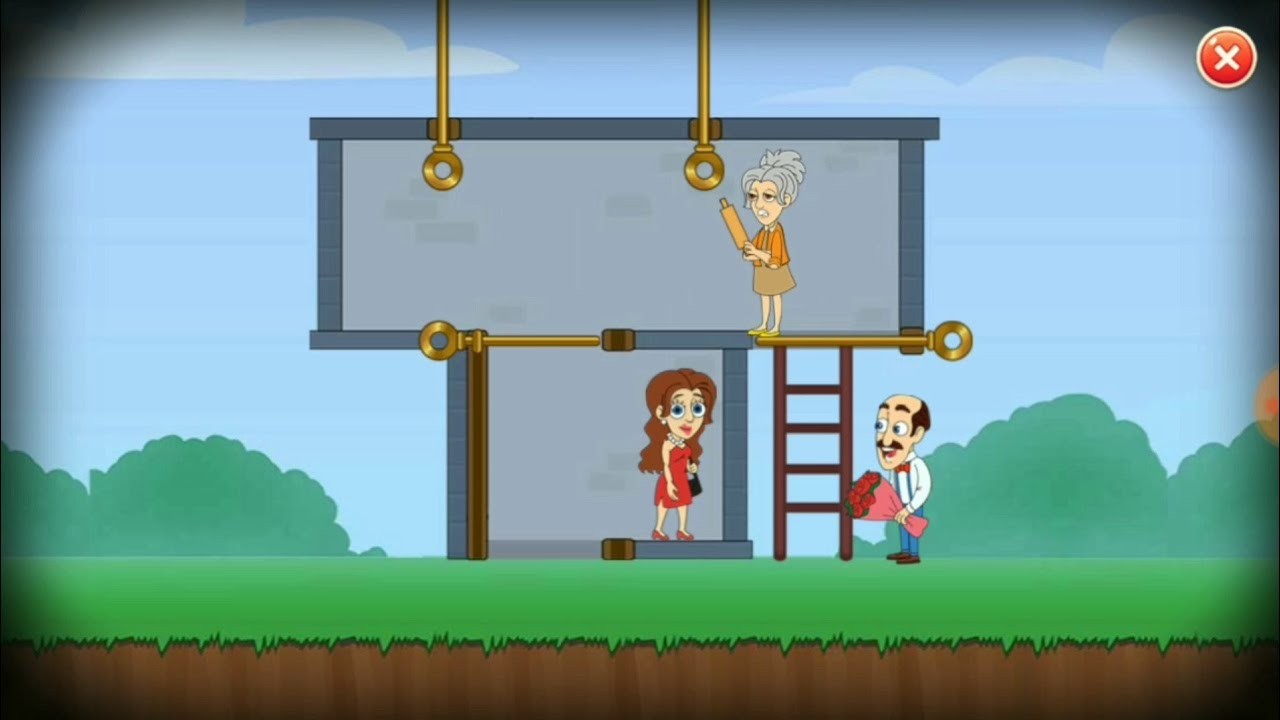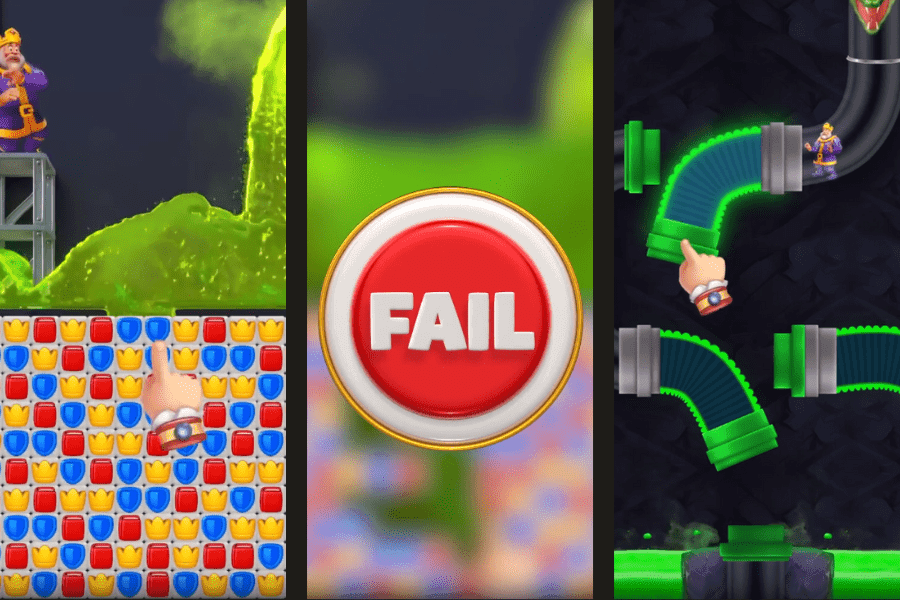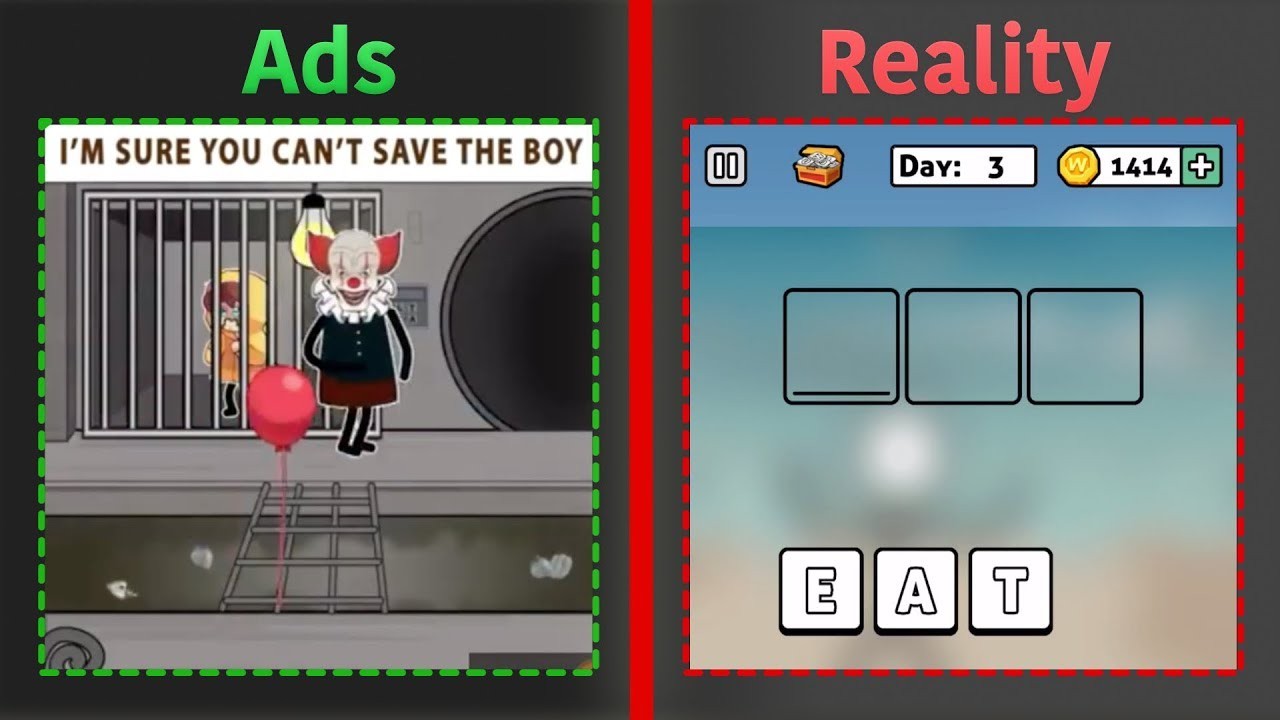Fake mobile game ads are everywhere—and if you’ve ever shouted “That’s not the game!” at your phone, you’re definitely not alone.
From failing puzzles in the dumbest way possible to ads that promise epic storylines and deliver… match-3, these ads have become a running joke online—and a huge part of how mobile games get millions of downloads.
But here’s the twist: they’re not just clickbait. They’re part of a bigger user acquisition strategy that actually works.
In this guide, we’re breaking it all down. Why fake mobile game ads exist. Why they convert like crazy. The psychology behind them. And yes, the perspective from those of us who actually make them (hi, that’s us).
Whether you’re a gamer who’s tired of getting duped or someone working in the gaming industry wondering why your UA team keeps asking for “fail ads,” this one’s for you.
Let’s get into it.
1. What Are Fake Mobile Game Ads?
If you’ve ever downloaded a game expecting one thing and ended up with something completely different, congrats—you’ve experienced a fake mobile game ad firsthand.
These ads usually look nothing like the actual game they’re promoting. They might show a totally different gameplay style, invent new characters or challenges, or build dramatic tension that doesn’t exist at all once you open the app.
So what qualifies as “fake”?
It’s not just bad graphics or weird voiceovers—it’s a deliberate mismatch between what’s shown in the ad and what you’ll actually play.

That could mean:
- Ads that showcase puzzle-solving when the real game is a match-3.
- Characters stuck in dangerous “pin-pulling” scenarios that don’t exist in the core gameplay.
- Wildly dramatic cutscenes in games that have zero story content.
- Strategic battles, survival games, or moral dilemmas… in what’s actually an idle clicker.
Sometimes these ads pull from mini-games that show up eventually, buried 20 levels deep. Other times, they’re built from scratch, purely to get your attention.
Still, despite how obviously fake they can be, they’re technically not always violating ad policies. If even part of what’s shown exists somewhere in the game—no matter how obscure—that’s usually enough to slip past platform rules.
And that’s how fake mobile game ads became one of the most common ad formats in mobile game marketing today.
2. Why Game Studios Keep Making Fake Ads
It’s easy to assume fake mobile game ads are just lazy or shady. But the real reason they’re everywhere? They work.
Behind every ad is one goal: get you to install the game. And in mobile marketing, installs are measured in dollars. Specifically, CPI—cost per install. The lower the CPI, the more installs a studio can afford, and the faster a game grows.
Fake ads often outperform “honest” ones in metrics like:
- Click-through rate (CTR): More people tap them.
- Watch time: They’re weird and unpredictable, so people don’t skip.
- Conversion rate: The curiosity they create actually gets people to download.
This makes them super attractive to performance marketers. Even if the ad has nothing to do with the game, if it brings in users for cheap—it’s a win.

And here’s the kicker: most studios don’t just make one ad. They test dozens or hundreds. That process is called creative testing. They try all kinds of styles—some genuine, some fake—and whichever one brings in users for the best price becomes the main campaign.
So it’s not always a conscious choice to “lie.�” It’s more like, “Well… that fake puzzle ad got a 40% lower CPI, so guess what we’re running with.”
Even big-budget games that don’t rely on ad revenue sometimes experiment with these ads just to see if they convert better. And when they do? The user acquisition campaign scales fast.
Of course, there’s a tradeoff.
High installs don’t always mean high retention. Plenty of people delete the game once they realize it’s not what they expected. But from a growth standpoint, fake ads are still a fast, cheap way to hit user acquisition targets—which is why studios keep making them.
3. The Psychology Behind Fake Mobile Game Ads
Fake mobile game ads aren’t just random nonsense—they’re built to get your attention, make you curious, and push you to download. And they do it by tapping into some powerful psychological principles.
Here’s a breakdown of the tricks they use—and why they’re so effective.
The Curiosity Gap
This is the big one. The ad shows you just enough to get your brain asking questions—but not enough to answer them.
Maybe there’s a puzzle that looks deceptively hard. Maybe a character is seconds away from disaster. Maybe it’s a decision screen: “Do you save the baby or the diamonds?”
Your brain fills in the blanks. You need to know what happens next. The only way to find out? Click. Download. Open the game.
Even if deep down you suspect the game won’t actually deliver what the ad promised, the curiosity gap is strong enough to override that skepticism.

Frustration Bait (a.k.a. “Fail Ads”)
You’ve definitely seen these: a character messes up the most obvious move in a puzzle. Pulls the wrong pin. Chooses the wrong door. Gets eaten by a monster… for the fifth time.
It’s infuriating—but that’s the point.
These ads are designed to make you think, “Are you serious? I could do that in my sleep.” And now, you’re not just watching. You’re engaged. You want to prove you’re smarter than the “player” in the ad.
This taps into what psychologists call reactance—a mental pushback against something frustrating or unfair. You see someone fail repeatedly at something simple, and you instinctively want to take control and do it right.
And that means clicking.
Power Fantasy Hooks
Another common tactic is showing you going from poor to rich, weak to powerful, rejected to respected—all in the span of a few seconds.
Examples:
- Level 1 Beggar ➡️ Level 100 King
- Make a million in 30 seconds!
- Outsmart the villain and win the treasure
These ads sell a fantasy that’s quick, easy, and satisfying. They’re not offering a game. They’re offering a feeling: of winning, of control, of success.
And even if you know the actual game won’t deliver on that fantasy, the promise is enough to drive clicks.
Visual Chaos and Surprise
Fake ads often use janky animation, weird pacing, or bizarre logic—on purpose.
Why?
Because your brain has gotten really good at ignoring polished, predictable ads. But if you see something strange—a poorly drawn character crying over spilled gold, or a boss battle that turns into a dating sim—you’ll stop scrolling.
That’s called pattern interruption.
It hijacks your attention by doing something unexpected. Whether it makes you laugh, cringe, or just go “What the hell was that?”, it works.
Immediate Stakes, Zero Context
Many fake ads drop you into the middle of a high-stakes situation. Someone’s drowning. There’s a fire. Zombies are breaking through the door. No intro, no setup—just action.
This activates your fight-or-flight response—a primal reaction to danger or urgency.
Even though it’s just a cartoon character, your brain treats it like it matters.
You feel like you have to help. And suddenly, you’re downloading a game that’s… actually just a farm builder.

Looping and Cliffhangers
A lot of fake ads never show how the scenario ends. Just before the puzzle is solved—or the decision is made—the video loops back to the beginning or cuts off.
It’s a subtle trick, but it works. You stay a little longer. Maybe you rewatch it. The ad platform registers more watch time and thinks, this ad is working. So it gets shown more. And eventually… you cave and tap it.
4. The Most Iconic Fake Mobile Game Ads (and Why They Blew Up)
If there’s one type of mobile game ad everyone remembers, it’s the one where someone fails miserably at a simple puzzle. A pin gets pulled. Lava pours in. A character dies. And you, watching from your screen, can’t help but think: “I could solve that in two seconds.”
That’s exactly the point.
These “fail ads” have become the most viral sub-genre of fake mobile game ads—and no one popularized them more than Playrix.

Homescapes: The Original Fake Ad Controversy
Let’s start with the pioneer. If you’ve spent any time playing mobile games, you’ve seen a Homescapes ad. You know the ones—pull the pins, save the character, avert a fire or flood, and… fail.
Here’s the truth: that’s not what the game is about.
Homescapes is a classic match-3 puzzle game with a decorating and narrative meta layer. The puzzles from the ads? They exist—but they are buried deep in the game. At launch, they accounted for less than 1% of the actual gameplay.
It became such a big deal that in 2020, The Advertising Standards Authority (ASA) in the UK banned some of Playrix’s ads, ruling them “misleading” because players had to complete a significant amount of unrelated gameplay to even reach the puzzles shown in the ads.
So why run them? Because they worked.
Playrix wasn’t targeting Candy Crush fans. That audience was already saturated. Instead, their ads targeted a broader group—people who enjoyed story-driven games, brainteasers, hidden object games, and emotional drama.
By using pin-pulling disasters or heartfelt narratives (like a custody battle or a renovation fail), they hooked players with narrative appeal and problem-solving instincts, not just tile-swapping.
Eventually, they added more of these puzzle mini-games to the actual app—likely to justify the ads and improve player retention. But even from the beginning, these ads weren’t random. They were highly strategic.

Royal Match: Mini-Game Trend
Royal Match took a similar approach—but with a twist.
In the ads, you’re helping King Robert survive all kinds of ridiculous disasters. He’s stuck in a flooding room. He’s being electrocuted. He’s about to fall into lava. And just like in the Homescapes ads—he always fails.
At first glance, it looks like the same bait-and-switch.
But here’s the difference: the core gameplay in Royal Match is still match-3, and the mini-game scenarios you see in the ads are actually part of the game. They’re called King’s Nightmare episodes, and they unlock after progressing through a certain number of levels.
So while the ads still fall into the “fail ad” category and push curiosity and challenge, they’re not entirely fake. They’re more of a stretch than a lie.
There’s also smart psychology at work here.
The fail ads make you feel like you could save King Robert. It becomes personal. You want to outsmart the AI and prevent a cartoon disaster. It’s not just about matching tiles—it’s about solving a challenge that someone else couldn’t.
And when you finally get to that King’s Nightmare mode in-game, it pays off with a little coin bonus—just enough to make the loop feel satisfying.

Evony: The Strategy Game Disguised as a Brawler
Evony’s fake ads are among the most recognizable out there. You’ve probably seen them: waves of enemies storming toward a hero who defeats them with a single tap in a kind of real-time battle puzzle.
But here’s the twist—Evony is actually a mid-core strategy game. The real gameplay is about resource management, alliances, city-building, and long-term tactical planning. Nothing about it resembles the fast-paced brawler chaos in the ads.
So why go hyper-casual in the marketing?
Because the ads generate massive attention. They appeal to players who want quick, action-heavy games—even if the game itself is slower, deeper, and more strategic. That curiosity brings in tons of installs, even if it comes with some confusion later on.

Hero Wars: Puzzle Bait Meets Mid-Core RPG
Hero Wars ads are another classic example of “fail ads” in action. They typically feature ultra-simple puzzles—like moving levers or avoiding traps—that the character fails at in increasingly dumb ways.
The viewer watches in disbelief, thinking: “That was so obvious. I could’ve done it right.”
This triggers a mix of curiosity and challenge that’s hard to ignore. You download the game expecting puzzles… and get a full-blown mid-core RPG with heroes, leveling systems, gear, and battles. No puzzles in sight—at least, not the ones from the ads.
Even though the bait-and-switch is obvious, the ads perform well because they tap into frustration, logic, and the desire to “do better.”
5. The Player Perspective: Love to Hate Them
Let’s be real—players know fake mobile game ads when they see them. And for the most part, they’re not fooled. But that hasn’t stopped these ads from becoming part of gaming culture.

It’s a Meme at This Point
You’ve probably seen entire YouTube compilations of “mobile game ads be like…” Or TikToks roasting the latest pin-pulling disaster. Or Reddit threads trying to actually find the mystery game from the ad—only to discover it doesn’t exist.
These ads are so consistently absurd that they’ve become a meme. People talk about them the same way they talk about outrageous reality TV—it’s bad, but you can’t look away.
Some players even download the game just to see how bad the bait-and-switch is. It’s a weird blend of curiosity, entertainment, and outrage that actually fuels installs.
But It’s Not All Fun and Games
On the flip side, a lot of players feel straight-up tricked. Especially if they’re not in on the joke.
You see a puzzle ad, expect a brain-teasing challenge, and end up with another Candy Crush clone. For casual players or younger audiences, that mismatch can be disappointing—and it shows in app store reviews.
Common complaints include:
- “This isn’t the game from the ad.”
- “Deceptive and misleading.”
- “Uninstalled after 5 minutes.”
There’s also a growing sense of fatigue. Once you’ve seen the same fake ad format twenty times, it stops being funny and starts being annoying.
Expectation vs. Experience
The biggest issue isn’t even that the ads are fake—it’s that they create the wrong expectations. When you expect one type of gameplay and get something totally different, it breaks trust. Even if the actual game is decent, that first impression can ruin the entire experience.
It’s the digital version of getting tricked into a movie by a misleading trailer. It leaves a bad taste—even if the content itself isn’t bad.
6. The Industry Perspective: Marketers, Devs, and Ad Networks
From the outside, it might seem like fake mobile game ads are just shady tactics that should be banned. But inside the industry, the conversation is… more complicated.
Different players in the mobile ad ecosystem—marketers, developers, and app publishers—all see things from slightly different angles. And that’s part of why fake ads are still going strong.
Marketers: Results Over Everything
For user acquisition (UA) teams and ad agencies like ours, the ultimate goal is to hit performance targets: low CPI, high install volume, strong engagement.
And here’s the thing: fake ads perform.
They often win in creative testing, beat out “honest” ads in cost and engagement, and scale quickly. If one weird puzzle ad brings in 40% more installs than a polished gameplay reel, guess which one gets the budget?
It’s not about tricking people—it’s about running what works. And when fake ads stop performing, they get cut. But as long as they’re the top performer in the campaign dashboard, they’re hard to walk away from.
Developers: Mixed Feelings
For game developers, fake ads can feel like a double-edged sword. On one hand, they bring in users. On the other, they sometimes misrepresent the game entirely.
That can lead to players bouncing fast, leaving negative reviews, or worse—assuming the devs intentionally lied. And in reality, many developers don’t have full control over ad creatives, especially in larger studios where UA is handled by a separate team or agency.
Some devs love the performance boost. Others hate that their game gets associated with “those kinds of ads.” But either way, they feel the pressure to compete in a market where everyone else is doing it.
App Publishers and Ad Monetization
There’s one more group that benefits from fake ads: publishers who host them.
Free-to-play games and apps make money by showing ads to users. So when a fake ad goes viral and starts getting shown in millions of impressions, the publisher earns more revenue.
Whether the ad is misleading doesn’t always matter—if it’s watchable, clickable, and monetizes well, it’s a win for the app it’s shown in.
This is part of why ad networks are packed with these creatives. They drive installs and generate revenue—even if they spark a few eye-rolls along the way.

7. Is the Fake Ad Era Ending?
If you’ve been thinking, “Surely this trend can’t last forever…”—you’re not wrong. While fake mobile game ads are still everywhere, the tide is starting to shift.
There are a few key reasons why the fake ad formula might finally be wearing thin.
Players Are Catching On
Let’s face it—players are smarter now. They’ve seen enough misleading ads to spot the patterns: the same fail scenarios, the same pin puzzles, the same dramatic decisions that never actually show up in the game.
The novelty has worn off.
What used to spark curiosity now triggers skepticism. And when you’ve been tricked more than once, you’re less likely to download again.
This growing awareness means fake ads don’t always perform the way they used to—especially for games that rely on long-term retention.
App Stores Are Tightening the Rules
Both Apple and Google have started paying more attention to ad transparency, especially when it comes to misleading creatives.
After Playrix got called out by the UK’s Advertising Standards Authority (ASA) in 2020, other developers took note. Since then, app store platforms have quietly pushed for more representative ad content. If a game’s ad shows completely different gameplay than what’s in the app, it’s more likely to get flagged, rejected, or penalized.
This doesn’t mean fake ads are banned—but it does mean advertisers are being more careful about how far they can stretch the truth.

Shifting Toward Playable, UGC, and Honest Ads
As fake ads lose their edge, new formats are gaining momentum—ones that are still entertaining, but more aligned with what the actual game delivers.
- Playable ads give users a taste of the real experience. For hyper-casual and rhythm games especially, they perform well without needing exaggeration.
- User-generated content (UGC) feels more relatable and honest, especially when it comes from real players or influencers.
- Narrative-driven trailers and “game moment” reels are helping mid-core games build hype in a way that still reflects real gameplay.
Advertisers are learning that honesty doesn’t have to be boring—as long as the hook is strong.
The Future? Somewhere in the Middle
Fake mobile game ads won’t disappear overnight. They’re too effective, too scalable, and still too cheap to ignore. But what we’re already seeing is a pivot toward hybrid strategies—ads that use emotional hooks, dramatic scenarios, or challenge-based formats, but still connect to real gameplay.
The best-performing creatives in 2025 aren’t always the most outrageous—they’re the ones that are clever, entertaining, and just believable enough.
8. Our Take (From the Team That Makes Game Ads)
We get it—fake mobile game ads are polarizing. As a mobile game marketing agency, we’ve tested them, scaled them, and seen exactly what they can do.
So here’s our honest take.
Where Fake Ads Work—and Where They Backfire
There’s no question: fake ads can drive installs. If the goal is to lower CPI and get users in the door fast, they’re often the top performers—especially in early testing phases. They’re attention-grabbing, emotional, and curiosity-inducing. That’s a powerful combo.
But we’ve also seen the other side.
When the gameplay doesn’t match the ad, you often get:
- High uninstall rates
- Poor retention
- Negative reviews
- Higher long-term acquisition costs
For games with short life cycles—like some hyper-casual titles—that might be okay. But for games that need strong Day 7 or Day 30 retention? Fake ads can hurt more than help.
In other words, they’re a tool—not a strategy. Great for testing and scaling quickly, risky if they’re all you rely on.
What We Recommend in 2025
In today’s market, what usually works best is a hybrid approach:
- Use strong hooks that grab attention in the first 3 seconds—but make sure they’re tied to the actual gameplay loop.
- Playables are your best friend if the game mechanics are intuitive and fun. Nothing beats letting someone try before they install.
- UGC-style ads feel real, relatable, and native to platforms like TikTok and Reels. They build trust, which pays off in retention.
- Humor, emotion, and surprise still work—but the trick is not to oversell.
Ultimately, the best ad is the one that gets attention and sets the right expectations. That way, players aren’t just downloading—they’re actually sticking around.
Final Thoughts on Fake Mobile Game Ads
Fake mobile game ads are ridiculous—and wildly effective. They’ve been banned, roasted, memed, and dissected… and yet they’re still everywhere.
Why?
Because they grab your attention, trigger curiosity, and—most importantly—get people to download.
For players, they’re a love-hate relationship. Annoying, sure. But also strangely addictive. You know the game won’t be what the ad promised, but something about it still pulls you in.
For marketers and developers, they’re a tool. Not perfect, not always ethical—but sometimes incredibly efficient. And when you’re competing for installs in one of the most crowded markets on the planet, performance often wins out.
But the trend is shifting. Players are getting wiser. Platforms are cracking down. And the next era of mobile game advertising is already starting to look more honest, more creative, and more connected to the games themselves.
Until then? Don’t be surprised if you see yet another puzzle ad where someone fails in the dumbest way possible—and don’t be shocked when you download it anyway.







Comments